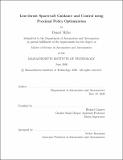Low-thrust Spacecraft guidance and control using proximal policy optimization
Author(s)
Miller, Daniel(Daniel Martin)
Download1191819251-MIT.pdf (1.489Mb)
Other Contributors
Massachusetts Institute of Technology. Department of Aeronautics and Astronautics.
Advisor
Richard Linares.
Terms of use
Metadata
Show full item recordAbstract
Artificial intelligence is a rapidly developing field that promises to revolutionize spaceflight with greater robotic autonomy and innovative decision making. However, it remains to be determined which applications are best addressed using this new technology. In the coming decades, future spacecraft will be required to possess autonomous guidance and control in the complex, nonlinear dynamical regimes of cis-lunar space. In the realm of trajectory design, current methods struggle with local minima, and searching large solutions spaces. This thesis investigates the use of the Reinforcement Learning (RL) algorithm Proximal Policy Optimization (PPO) for solving low-thrust spacecraft guidance and control problems. First, an agent is trained to complete a 302 day mass-optimal low-thrust transfer between the Earth and Mars. This is accomplished while only providing the agent with information regarding its own state and that of Mars. By comparing these results to those generated by the Evolutionary Mission Trajectory Generator (EMTG), the optimality of the trajectory designed using PPO is assessed. Next, an agent is trained as an onboard regulator capable of correcting state errors and following pre-calculated transfers between libration point orbits. The feasibility of this method is examined by evaluating the agent's ability to correct varying levels of initial state error via Monte Carlo testing. The generalizability of the agent's control solution is appraised on three similar transfers of increasing difficulty not seen during the training process. The results show both the promise of the proposed PPO methodology and its limitations, which are discussed.
Description
Thesis: S.M., Massachusetts Institute of Technology, Department of Aeronautics and Astronautics, May, 2020 Cataloged from the official PDF of thesis. Includes bibliographical references (pages 101-107).
Date issued
2020Department
Massachusetts Institute of Technology. Department of Aeronautics and AstronauticsPublisher
Massachusetts Institute of Technology
Keywords
Aeronautics and Astronautics.